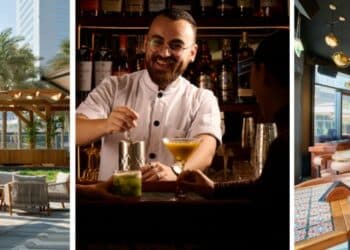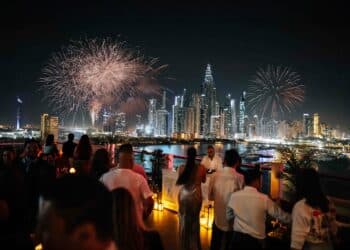Phil Crozier, director of wine for Gaucho Restaurants discusses his mission to open Dubai up to an exciting new world of Argentinian vintages, and the unique challenges he faces along the way

As the fifth largest wine producer in the world, yielding more than Chile, Argentina, and New Zealand put together, it’s surprising that Argentine grape is so under-represented on the global marketplace. According to Phil Crozier, director of wine for Argentinian steakhouse brand, Gaucho Restaurants Argentine varieties make up just 2% of the UK market, one of the most competitive beverage markets in the world.
And in Dubai, a very young market for grape, Argentine products have only been around for a few years and face a number of challenges due to the extremely limited beverage supply chain in the emirate, as well as a lack of education on the product. When Gaucho Dubai first opened in October 2011, there was “virtually nothing”, according to Crozier, who looks after a portfolio of 14 Gaucho venues in London and the Hong Kong and Dubai locations. Yet today he believes “there is quite a good showing” of Argentine beverages and he has made it his mission to help open the market up even further, both in Dubai and the UK.
Crozier even complained to the Wine & Spirit Education Trust (WSET) – the international body for educating sommeliers – that the Level three section on Argentina was “a joke”, and offered to re-write it. Having penned 17 pages on Argentine grape, WSET came back to him and said Argentina couldn’t possibly have 17 pages dedicated to it – because Bordeaux only had 16.
“[WSET] is not currently in touch with what’s going on in the beverage world, which changes so quickly,” says Crozier. “The point is we need to start thinking differently about the world of wine because at the moment, we’re educated about Bordeaux, Burgundy, Italy and Spain and then there’s everything else. The world of wine is very different to that, and we need to reflect it.”

And it’s not just the country of Argentina that Crozier wants to promote, but the sub-regions too.
“In the not-too-distant future I want people to come into the restaurant and say ‘I like my Malbec from the Uco Valley; I like my Malbec from Lujan de Cuyo; I like my Malbec from Patagonia’. That’s not going to happen until we start selling the products on that basis – which we do – but it will take time for people to understand,” he says.
But getting people to understand requires education, and with Argentine beverages so under-represented everywhere, including Dubai, consumer knowledge is a barrier to its growth, and to further demand.
Crozier does his share, visiting Dubai each year to update the beverage list, carry out tasting sessions with customers, and generally act as an ambassador for Argentine beverages in Dubai. He does the same in London, working the floor four nights a week at different Gaucho restaurants as a sommelier, and enjoying the unique position of being at the forefront of the entire process, from commissioning, to importing, and then the final sale to the customer.
“Some beverages are deep, dark, rich and voluptuous. Others have tonnes of energy; you have to think about it; they challenge you; they are very high in acidity; they’re very fresh and have a lot of youth and vibrancy. To me, this is where the business is going”
“It gives you a very unique insight into what sells, what doesn’t sell, what people like, and what they don’t like, and most of that is education,” he says.
And while the London restaurants have roughly 200 varieties each, Dubai has only 120, which is down to the challenges presented by having just two suppliers – Maritime and Mercantile International (MMI) and African & Eastern. This means that far fewer options are available on the market, and up until recently, Gaucho had relied mainly on special imports.
“I’d like to see an increase in the diversity of wines. Right now we have a number of special imports, but with importers now bringing in new wineries from Argentina, it gives us a little bit more flexibility because it means we’re not having to rely so much on special imports, which logistically is really difficult and puts a strain on the resources of the importers,” he says.
Crozier currently works with 65 wineries and produces beverages with every one of them, including those specially commissioned for Gaucho, such as Susanna Balbo blends. “I’ll go to Susanna Balbo and she’ll line up a range of single vineyard wines of different grape varieties before she does her blends and I’ll say, ‘ok, I like that one – let’s make 250 cases of it’. It will be a Susanna Balbo wine but it will be our own brand developed with her,” he explains.
Revealing he’d like to do more commissioning, Crozier says that more restaurants in Dubai have to buy from Argentina in the first instance. “It lessens the exposure of the two importers, which is a very unique challenge. If I were asking them to do 200 wines just for Gaucho, imagine what their stockholding would have to be like!” he says, explaining that in the UK it’s different because while you may have 200 wineries with 200 importers, they all have agencies, which makes it easier. Nevertheless, sourcing a portfolio of all-Argentine bottles has its challenges, even in London.

“If you want to do all Argentine, you have to go as close to the source as possible, which means going to the agency, which is normally a wholesaler. If nobody else can do Susanna Balbo products, for example, you have to buy from there, so that means I have 25 suppliers. Logistically, when you’ve got 14 restaurants, that’s not easy!”
Crozier regularly visits Argentina to taste the Gaucho produce, staying in a house near the company’s 6.5-hectare vineyard, which was planted in 1929. An agronomist looks after the vineyard and Crozier tastes the beverage after it has been in oak for a year and decides whether it’s going to be made into a barrel selection. If so, it gets kept in the bottle for an extra year, and while the yield is low, the quality is high. There is one wine maker employed full time and Crozier occasionally brings another maker into the vineyard to create a different product, explaining that the people are just as important as the terroir.
“Different wine makers make different wines and you can see the difference in the human element. I want to make this much more of a focus because Argentina is a nation of immigrants – it has Spanish, French and Italian influence,” he says.

Plans for Gaucho Dubai mainly revolve around people, as Crozier looks to bring in the latest creations from the new kids on the block, in particular the Michelini brothers, four siblings producing in Gualtallary, a sub-region of the Uco Valley where the soil has high levels of calcium, resulting in a ‘boney’ quality to the product.
Referring to the brothers, Crozier says: “They’re very much the young, cool, rock and roll of wine makers and are doing things very differently. They have a clear vision, are very esoteric and are breaking the mould with new grape varieties. Their wines are electric; they are just full of energy,” says Crozier, who believes that varieties such as these are the future for the industry.
“Some beverages are deep, dark, rich and voluptuous. Others have tonnes of energy, you have to think about it; they challenge you; they are very high in acidity; they’re very fresh, and have a lot of youth and vibrancy. To me, this is where the business is going,” he says.
And there is a lot more potential for Argentina in the Dubai market, according to Crozier, who believes Gaucho needs to be leading the revolution by introducing new varieties and “shouting about them from the rooftops”. That said, he also wants to see other restaurants in the emirate doing their bit – and he believes this is starting to happen.
“I think a lot of young sommeliers are seeing the world in a much more expansive way – that it’s not just Burgundy and Bordeaux. They are embracing new places, putting some diversity on their lists, and hopefully they’ll have space for Argentina and some new products from there. That’s what I’d like to see,” he concludes.


































































